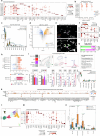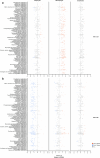Selective remodelling of the adipose niche in obesity and weight loss
- PMID: 40634602
- PMCID: PMC12367556
- DOI: 10.1038/s41586-025-09233-2
Selective remodelling of the adipose niche in obesity and weight loss
Abstract
Weight loss significantly improves metabolic and cardiovascular health in people with obesity1-3. The remodelling of adipose tissue (AT) is central to these varied and important clinical effects4. However, surprisingly little is known about the underlying mechanisms, presenting a barrier to treatment advances. Here we report a spatially resolved single-nucleus atlas (comprising 171,247 cells from 70 people) investigating the cell types, molecular events and regulatory factors that reshape human AT, and thus metabolic health, in obesity and therapeutic weight loss. We discover selective vulnerability to senescence in metabolic, precursor and vascular cells and reveal that senescence is potently reversed by weight loss. We define gene regulatory mechanisms and tissue signals that may drive a degenerative cycle of senescence, tissue injury and metabolic dysfunction. We find that weight loss reduces adipocyte hypertrophy and biomechanical constraint pathways, activating global metabolic flux and bioenergetic substrate cycles that may mediate systemic improvements in metabolic health. In the immune compartment, we demonstrate that weight loss represses obesity-induced macrophage infiltration but does not completely reverse activation, leaving these cells primed to trigger potential weight regain and worsen metabolic dysfunction. Throughout, we map cells to tissue niches to understand the collective determinants of tissue injury and recovery. Overall, our complementary single-nucleus and spatial datasets offer unprecedented insights into the basis of obese AT dysfunction and its reversal by weight loss and are a key resource for mechanistic and therapeutic exploration.
© 2025. The Author(s).
Conflict of interest statement
Competing interests: R.L.B. participated in committees or advisory boards for ViiV Healthcare, Gila Therapeutics, Novo Nordisk, Pfizer, Eil Lilly, the Royal College of Physicians, NHS England, the National Institute for Health and Care Excellence, the British Obesity and Metabolic Surgery Society, the National Bariatric Surgery Registry, the Association for the Study of Obesity, the Obesity Health Alliance, the International Federation for the Surgery for Obesity and Metabolic Diseases, Obesity Empowerment Network UK and the European Society for Endocrinology. R.L.B. has undertaken consultancy work for Novo Nordisk, ViiV Healthcare and Epitomee Medical, and is employed by Eli Lilly. The remaining authors declare no competing interests.
Figures















References
-
- Lean, M. E. et al. Primary care-led weight management for remission of type 2 diabetes (DiRECT): an open-label, cluster-randomised trial. Lancet391, 541–551 (2018). - PubMed
-
- Look AHEAD Research Group et al.Association of the magnitude of weight loss and changes in physical fitness with long-term cardiovascular disease outcomes in overweight or obese people with type 2 diabetes: a post-hoc analysis of the Look AHEAD randomised clinical trial. Lancet Diabetes Endocrinol.4, 913–921 (2016). - PMC - PubMed
-
- Blüher, M. et al. New insights into the treatment of obesity. Diabetes, Obes. Metab.25, 2058–2072 (2023). - PubMed
MeSH terms
Grants and funding
LinkOut - more resources
Full Text Sources
Medical

